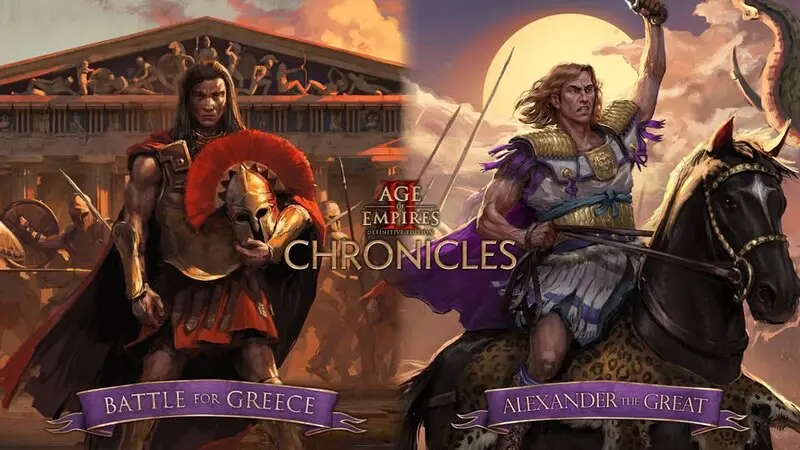Chronicles: Alexander the Great – Age of Empires II: Definitive Edition’s newest DLC

The new Age of Empires II: Definitive Edition DLC: Alexander the Great, just came out this week. Age of Empires II: Definitive Edition’s latest Chronicles chapter drops players into the whirlwind career of Alexander the Great. Chronicles: Alexander the Great arrives as a narrative-driven single-player expansion that mixes the series’ classic base-building and army-management gameplay with a stronger storytelling focus, curated mission design, and new toys for players to experiment with. Below I’ll walk through what’s included, how the campaign is structured, what the three new civilizations bring to the table, the design choices that make this Chronicles entry distinctive, how it handles history, and practical tips for players who want to master Alexander’s age of conquest.
What’s in the box: scope and key features in Chronicles: Alexander the Great
At a glance, Chronicles: Alexander the Great ships as a Chronicles-style expansion — meaning the focus is single-player narrative scenarios rather than ranked multiplayer civ additions. The DLC includes:
- A full Alexander campaign tracing his life from youth to the zenith of his empire. The campaign is built as a sequence of scenarios (sources cite an 18-scenario structure).
- Three new playable civilizations added for use in skirmish and custom modes (non-ranked): historically themed Macedonians and two neighboring peoples (various previews list three civs introduced by the DLC).
- Updated audiovisual presentation for the Chronicles series: animated cutscenes, narrated mission intros, and scenario objectives tailored to story beats.
- Quality-of-life and patch updates released alongside the DLC, which include new achievements, scenario tweaks, and engine adjustments referenced in the official patch notes.
The DLC launched across PC (Steam / Microsoft Store / Xbox) and, notably, is available on PlayStation 5 at launch as well — a sign of the franchise’s ongoing platform widening.
Age of Empires II: DE – Chronicles: Battle for Greece
It is worth mentioning that if you have not played Chronicles: Battle for Greece, you should play that before playing Alexander the Great, because it sets the story of what happened before Alexander the Great set out against the Persian Empire. Battle for Greece covers the period of the Persian wars when Persia tried to invade Greece but failed and set the stage for Alexander the Great’s rise. If you can’t play Battle for Greece, you can instead watch the cinematic movie below which takes all the cinematic sequences between missions and puts them together to tell the story in the game.
The campaign: pacing, scenarios, and player agency
Chronicles entries are explicitly designed to tell a story through scenarios that each spotlight a moment in a historical life. For Alexander, that storytelling approach allows designers to move beyond repetitive “build-to-attack” missions and craft scenes that reflect varied phases: tutelage under Philip II, the consolidation of Macedon, the siegecraft of the eastern campaigns, logistics and city founding, and the interplay of politics and legend that surround Alexander’s image.
Multiple sources and community previews indicate an emphasis on variety and pacing: the designers reportedly reduced reliance on strict timers (a common criticism of earlier mission types) to let players approach objectives more deliberately and explore alternate strategies. Some missions are described as almost “city-builder” in spirit (for example, building Alexandria Eschate and managing its development), while others put you in large set-piece battles that test combined arms and maneuver. This mixture keeps the campaign feeling cinematic without becoming monotonous.
Design choices worth noting:
- Narrative framing: Animated cutscenes and narrated mission briefings attach emotional and political stakes to otherwise mechanical tasks. That framing helps contextualize why you must take a particular objective, rather than leaving it as an abstract numeric goal.
- Scenario variety: Expect siege puzzles, river crossings, holding actions against superior numbers, and a few custom-rule missions where you control a small elite rather than mass armies. Community previews mention scenarios built to reward clever play over brute force.
- Accessibility: Chronicles scenarios are often somewhat gentler for players newer to AoE II’s minute-by-minute mechanics, allowing fans of historical storytelling to enjoy the campaign without the pressure of ladder-level micro. That said, each scenario is still rich with tactical depth for veterans.
The three new civilizations: identity and gameplay implications
One of the DLC’s larger gameplay takeaways is the addition of three new civilizations. Chronicles entries often focus on flavor and single-player balance rather than disrupting ranked multiplayer — the civs are usually marked as non-ranked/custom lobby civs — but they nonetheless introduce fresh unit rosters, technologies, and civ bonuses that open new strategies in skirmish and custom play. Steam and official posts advertise three new civs tied to the Macedonian world; previews list names and thematic direction (Macedonians, Thracians and Puru).
What to expect from Civ design:
- Macedonians: Likely to center on heavy shock infantry (sarissas/pikemen analogues), elite companion cavalry, and bonuses tied to siege or road logistics — reflecting Macedonian military innovation. If implemented, they should excel at combined arms and staged pushes rather than pure rushes.
- Neighboring civs: The other two new civs (Thracians and Puru) appear to represent the Persian and regional tribal factions Alexander encountered. Those civs typically bring asymmetrical mechanics: more mercenary-style troops, unique cavalry forms, or economy/army-forging quirks that reward different macro decisions.
Important practical note: since these are Chronicles civs, they are generally non-ranked and meant for custom lobbies and single-player use. If you’re primarily a competitive ladder player, these civs won’t immediately reshuffle ranked metagame balance — but they’re great experimentation platforms in casual games and for single-player challenges.
Visuals, sound, and presentation in Chronicles: Alexander the Great
The Chronicles series has leaned into cinematic retelling, and Alexander the Great follows suit: official posts and trailers promise animated cutscenes and enhanced audio narration that dramatize events. These elements serve two purposes: they create a more immersive narrative arc, and they give the campaign missions clearer context so each objective feels like a beat in a life story rather than a standalone puzzle. The trailer and announcement materials underscore polished artwork, voiceover, and scenario staging.
From a design perspective, this is a welcome continuation of the DLC’s role as a bridge between strict strategy sim and accessible historical narrative — it’s an entry point for players who enjoy history and spectacle alongside classic AoE mechanics.
Historical fidelity and representational choices
Portraying Alexander means balancing myth and complexity. The campaign’s narrative beat format naturally privileges dramatic moments (Gordian Knot, Granicus, Issus, Gaugamela, the founding of cities like Alexandria Eschate) and is therefore selective in scope. Previews and community conversations note that the DLC leans into the sweep and romance of Alexander’s story but also nods to the logistical, political, and cultural realities of campaigning across diverse lands (e.g., founding and administering cities, interactions with local elites). That approach is consistent with Chronicles’ mandate: evoke the historical figure rather than produce a full academic biography.
Players and historians will likely debate omissions and emphasis (as always): Alexander’s complex legacy — from Hellenizing policies to the contested motives behind certain campaigns — can’t be fully explored in a game campaign. But the DLC’s design choices (less emphasis on timed “rubber stamp” victories, more emphasis on settlement and politics in certain scenarios) suggest the developers tried to show more than just battlefield heroics. Community responses—visible on forums and social channels—indicate many players appreciate the variety and narrative effort, while some call for deeper nuance in future iterations.
If you want to learn more about history, visit our Greek history crash course page.
How it changes the player experience (and what to try first)
If you’ve played previous Chronicles entries (for example, Battle for Greece), you’ll notice a few concrete player-facing differences in Alexander’s chapter:
- Scenario variety rewards planning over speed. Several missions are built so you can approach them like mini-campaign puzzles: build, stabilize, then project power — instead of “win before the timer.” That frees you to try different unit mixes and civ bonuses.
- Custom armies and aesthetic options. The DLC emphasizes a curated army and cosmetic customization in campaign play, letting players take ownership of their “Alexander” force as it evolves scenario to scenario. Expect the campaign to let you carry certain units or upgrades forward in narrative terms.
- New civs for skirmish experimentation. Even if you avoid the campaign, the three new civs are worth trying in custom games to learn niches: new cavalry doctrines, shock infantry tactics, or economy modifiers that reward alternate strategies.
Quick beginner tips for the campaign:
- Scout early and often. Several Alexander scenarios are asymmetric — knowing where resources and choke points are will let you execute combined-arms timings cleanly.
- Use mercenaries/partners. Where the scenario limits your unit roster, treat allied/mercenary troops as force multipliers; the DLC occasionally expects you to stitch local troops into your army.
- Think like a logistics officer. In “city-builder” style missions (e.g., founding Alexandria Eschate), prioritize infrastructure that produces steady resources over short-term military output — those settlements are long-game assets.
Community reaction and early impressions
Initial community chatter (Reddit threads, Steam user reviews, early previews) skews positive on storytelling and mission variety. Players praise the cinematic touches, animated sequences, and the reduced reliance on timers. Some early criticisms are typical for a Chronicles release: questions about how much the new civs will matter to ranked play, and calls for even more historical nuance in character interactions. Steam user reviews early after launch show a “Mostly Positive” trend at the time of writing, which is common for single-player focused DLC that targets existing fans.
Verdict: where Alexander the Great fits in the AoE2 universe
Chronicles: Alexander the Great is not intended as a radical reinvention of AoE2; instead, it’s a focused single-player experience that expands the game’s narrative catalog while giving casual and solo players new civs and scenarios to explore. If you enjoy historical campaigns with cinematic presentation, mission variety, and the chance to play around with new civ concepts in custom games, this DLC is one of the stronger Chronicles entries to date. For competitive ladder players, it’s a flavorful expansion to test in private matches but not a metagame-shaker for ranked play.
From a design standpoint, the DLC continues a pattern: enrich single-player storytelling and provide safe, exciting playgrounds for creative strategies without destabilizing the competitive ecosystem — and in doing so, it keeps AoE2’s single-player catalog fresh and approachable for players who care more about narrative than ladder spreadsheets.
Final thoughts and recommendations
- Buy if: you love historical storytelling, want a cinematic AoE2 campaign with varied missions, or enjoy tinkering with new civs in custom games. The campaign’s emphasis on pacing and variety makes it an excellent solo experience. You can get the game here on Steam.
- Skip (for now) if: you only play ranked ladder and prefer balance changes that affect the competitive pool — Chronicles civs are typically non-ranked and mostly cosmetic/experimental for multiplayer.
- Must-try scenarios: any mission that tasks you with founding or managing a city (these represent an atypical, slower AoE playstyle), plus any large pitched-battle scenaria where combined arms and maneuver rule the day. Community previews highlight several of these as standout moments.
Discover more from Hellenic Moon
Subscribe to get the latest posts sent to your email.


